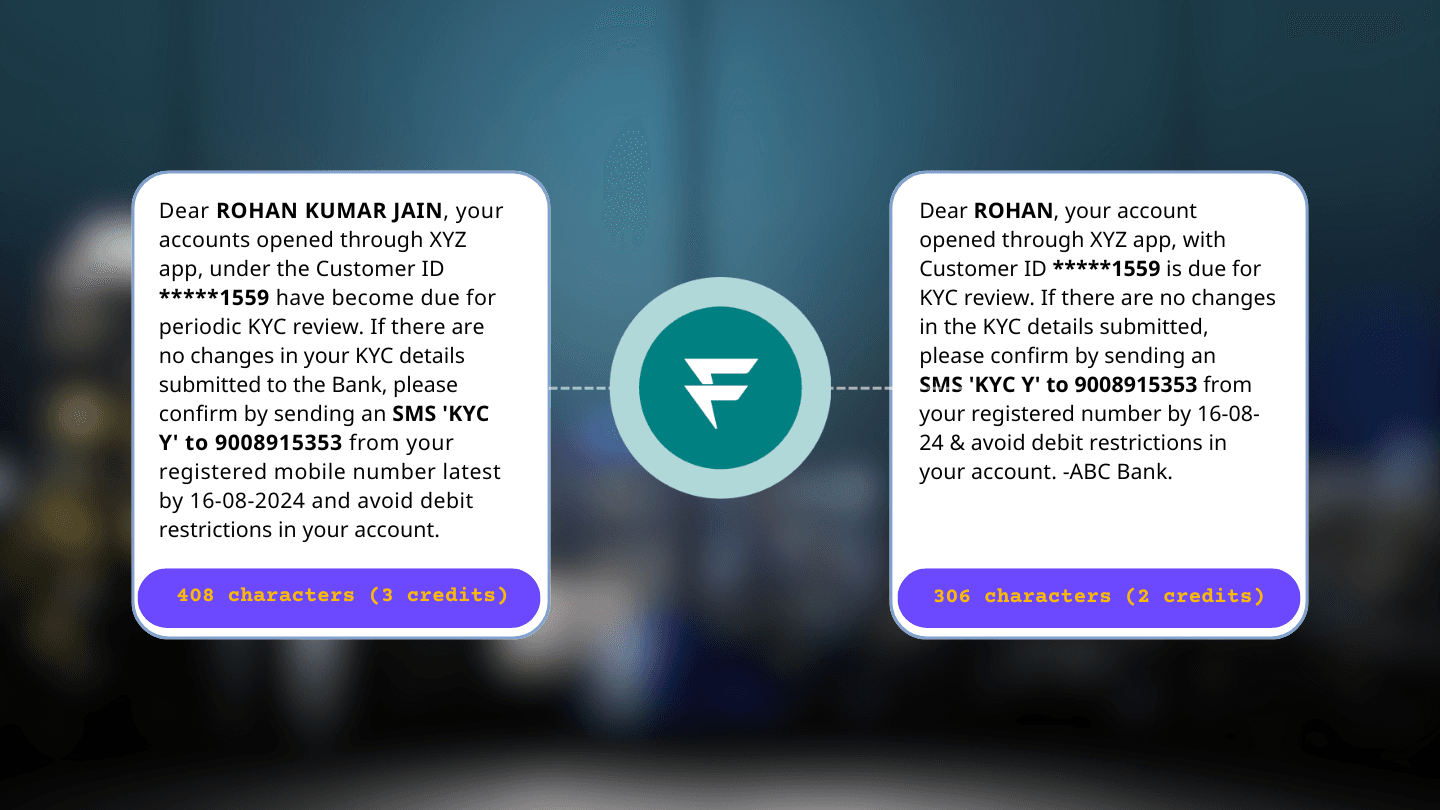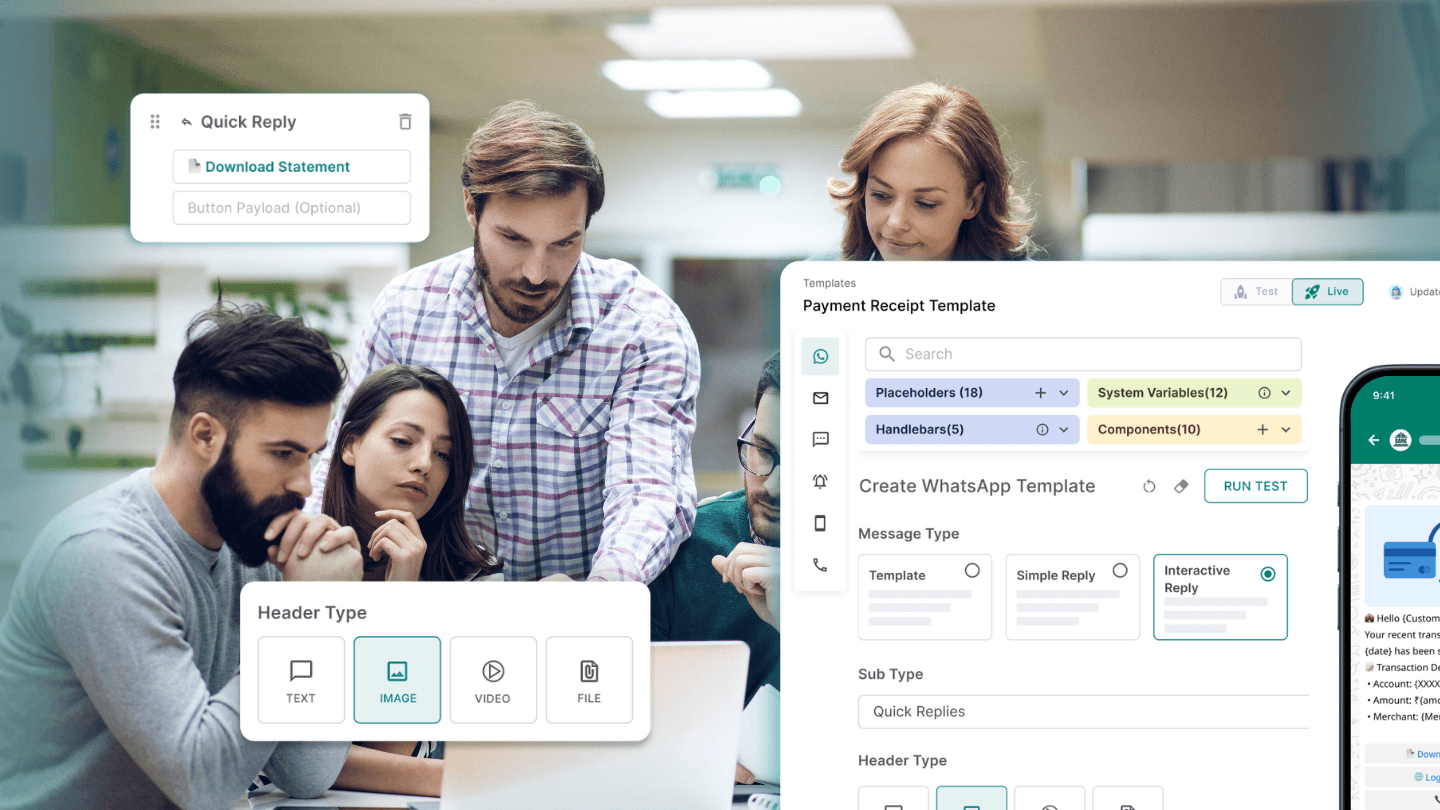Consider you’re sending a transactional SMS like this:
"Dear [CustomerName], your account ending in [Last4Digits] was debited with INR [Amount] on [Date]. Your updated balance is INR [BalanceAmount]."
On the surface, it seems straightforward. But let’s unpack the technical and cost implications. For "Amy," this message might fit within one segment, but for "Alexandria," the additional characters could push it into a second segment, instantly doubling the cost.
Now, what if there are unicode complications? Let’s say you want to add special characters like emojis or non-Latin scripts for multilingual regions, the character count in the seemingly single SMS would jump multifold and inflate costs.
Now scale this scenario across millions of messages sent daily by BFSI and logistics enterprises. The result? Skyrocketing costs tied to personalization complexity, compliance requirements, and dynamic routing.
For engineers and product managers, the challenge is twofold: architect systems that can handle these dynamic demands while optimizing for costs and reliability.
This blog dives into the hidden drivers of SMS personalization costs, the engineering hurdles at scale, and strategies to build smarter, cost-efficient communication systems that don’t compromise.

What makes personalization crucial?
In the BFSI sector, timely and accurate communication is non-negotiable. For example:
- Fraud alerts must include transaction-specific details, such as amount and merchant name, to prompt immediate action.
- Loan reminders need to consider customer-specific interest rates and tenure to remain relevant.Personalized messages reassure customers that the institution understands their needs and is committed to safeguarding their interests.
For logistics, personalization enhances operational transparency:
- Dynamic delivery updates tailored to the recipient's location improve customer experience.
- Feedback requests post-delivery can be personalized with shipment details to boost response rates.
Personalized messaging as a competitive advantage
Enterprises operating in saturated markets must differentiate themselves. Personalized SMS communication ensures messages are not only received but also acted upon.
The stakes are high in BFSI, where customer churn can result from impersonal communication, and in logistics, where delivery reliability directly affects brand reputation.
Engineering impact
While marketing teams may focus on engagement, engineering teams face the technical challenge of scaling such systems without compromising on reliability, delivery rates, or compliance. Personalization adds a layer of complexity that requires robust infrastructure and real-time data processing capabilities.
Breaking down the cost drivers of SMS personalization
Personalization in SMS communication involves more than simply adding a customer’s name to a message. For enterprise teams in BFSI and logistics, personalization demands sophisticated engineering and operational processes, which inevitably drive costs upward.
Below are the core cost drivers contributing to the higher expense of personalized SMS communication.
1. Increased API calls and segmentation overhead
Personalized SMS requires dynamic segmentation and real-time message generation, which multiplies the number of API calls to backend systems.
- Data fetch operations: Personalized messages must pull customer-specific data (e.g., transaction details or delivery timelines) from CRM systems, databases, or customer data platforms (CDPs).
- Real-time segmentation: APIs are invoked to identify the right audience segment based on criteria like location, behavior, or transaction history. For example, logistics companies need APIs to dynamically assign delivery routes, while BFSI uses APIs to segment customers by account type or credit score.
These API interactions not only consume compute resources but also increase latency and network costs, especially for enterprises operating at scale.
2. Template variability and compliance
Unlike bulk SMS, which relies on standardized templates, personalized SMS campaigns often require multiple template variations to cater to diverse audiences.
- Complexity in template approval: For BFSI, templates must adhere to strict regulatory frameworks, such as TRAI in India or GDPR in Europe, requiring pre-approvals for each variation. This adds compliance-related overhead.
- Localization and language support: Personalized messaging in logistics often involves region-specific languages and content adjustments, increasing the cost of template management.
For example, a BFSI company sending loan reminders across multilingual regions might need 20+ variations of the same message to ensure relevance, each requiring regulatory clearance.
3. Dynamic content and data processing costs
Generating dynamic content for personalized SMS involves real-time data processing, which adds computational overhead:
- Dynamic fields: Information such as customer names, account details, or shipment tracking links must be injected dynamically into SMS templates at runtime. This requires integration with robust middleware.
- Data validation and integrity checks: For BFSI, ensuring the accuracy of financial details like transaction amounts or due dates demands additional processing. For logistics, validating shipment statuses or delivery ETAs increases complexity.
The cost escalates further when message generation requires advanced computations, such as calculating interest rates or estimated delivery windows, in real-time.
4. Delivery failures and retries
Delivery failures can occur due to:
- Invalid or outdated customer data (e.g., phone numbers).
- Errors in dynamic message fields, such as missing data or incorrect formatting.
For logistics, incorrect routing information could mean failed notifications about deliveries. In BFSI, failure to deliver critical alerts like OTPs can lead to customer dissatisfaction or security risks.
Cost implication: Failed messages trigger automatic retries, incurring additional charges for every attempt. Engineering teams must implement logic to minimize failures, such as pre-validation of recipient data.
5. Smart routing complexity
Enterprises aiming to optimize costs often adopt smart routing strategies. However, personalized SMS disrupts traditional routing efficiencies:
- Routing depends on the message's nature and recipient’s geography.
- Personalized messages require dynamic routing adjustments based on delivery urgency.
For instance, a logistics firm may need to prioritize updates for shipments nearing delivery deadlines, while BFSI must ensure immediate delivery of OTPs. The dynamic nature of such routing increases costs compared to bulk messaging.
Engineering challenges
- Scalability: Building systems capable of handling high-frequency API calls and dynamic routing without performance degradation.
- Reliability: Ensuring message delivery even with increased retry rates and processing complexity.
- Compliance: Maintaining regulatory adherence across diverse geographies and message templates.
Technical challenges amplifying costs
Delivering personalized SMS at scale presents several technical challenges for BFSI and logistics enterprises. These challenges are not merely operational but demand robust engineering solutions, which often increase costs.
Below are the key technical obstacles that complicate personalized SMS systems.
1. Legacy systems and integration complexities
Many BFSI and logistics enterprises still rely on legacy infrastructure, making integration with modern systems challenging:
- Data accessibility issues: Legacy systems often store data in silos, complicating real-time data retrieval required for personalization.
- API incompatibility: Bridging legacy applications with modern APIs involves middleware solutions, which add latency and development costs.
For example, a BFSI institution using a decades-old core banking system may face significant overhead in extracting real-time account data for SMS personalization.
2. Handling massive data volumes
Enterprises generate vast amounts of data daily:
- BFSI: Millions of transactional records, account activities, and customer interactions.
- Logistics: Data from tracking systems, inventory, and delivery networks.
Challenge: Processing these volumes in real-time for personalization requires advanced computational resources, driving up cloud or server infrastructure costs. This is particularly demanding for high-frequency SMS systems like OTP notifications or shipment updates.
3. Dynamic template errors
Dynamic fields (e.g., names, account balances, delivery times) in SMS templates increase the risk of errors:
- Invalid or missing data: If real-time data is unavailable or incomplete, it can result in broken messages, failed deliveries, or compliance violations.
- Formatting issues: Complex templates with multiple variables (e.g., currency formats in BFSI or delivery slots in logistics) require extensive validation before dispatch.
Engineering teams must invest in robust validation pipelines and error-handling mechanisms, which add development and operational costs.
4. Security and compliance overheads
Personalization often involves sensitive data such as financial transactions or customer addresses. Protecting this data introduces additional challenges:
- Data encryption: Encrypting SMS payloads increases computational overhead.
- Regulatory compliance: BFSI enterprises must adhere to frameworks like PCI DSS for financial data and GDPR for customer privacy. Similarly, logistics companies handling cross-border deliveries face data sovereignty regulations.
Non-compliance can lead to costly fines, driving the need for secure and auditable communication systems.
5. Scalability challenges in high-traffic scenarios
Personalized SMS systems must handle unpredictable spikes in traffic:
- BFSI: High volumes of OTP requests during payment gateways’ peak hours.
- Logistics: Surge in delivery updates during seasonal sales or promotions.
Scaling backend systems to meet such demand requires advanced load-balancing strategies and elastic infrastructure, increasing both setup and ongoing costs.
6. AI and machine learning complexity
Enterprises leveraging AI for predictive personalization face additional technical hurdles:
- Model training and inference: Building models to predict customer behavior or optimize message content demands significant computational resources.
- Data drift issues: Personalized systems must continuously adapt to changing customer patterns, requiring regular retraining of AI models.
These processes not only incur infrastructure costs but also require specialized engineering expertise, raising overall operational expenses.
7. High retry rates and failed deliveries
Failed SMS deliveries result in higher retry rates, often caused by:
- Outdated or incorrect customer contact information.
- Delivery bottlenecks in rural or international regions.
Retries generate additional API calls and incur charges from SMS gateway providers, impacting cost-efficiency.
Fyno's dynamic credit calculation: A cost-saving strategy
One of Fyno’s standout features for SMS personalization is its real-time credit calculation system. Fyno evaluates the total character count, encoding type, and message structure to predict how many credits a single message will consume.
This functionality is invaluable for BFSI and logistics enterprises managing high-volume, dynamic SMS systems.
How Fyno's credit calculation works
Dynamic character count in real time: We continuously track the total number of characters in the SMS, including static and dynamic fields like (or) When a message exceeds the 160-character limit for GSM-7 encoding or the 70-character limit for Unicode encoding, we ensure visibility into how many credits each message will use.
Example: In BFSI, if an OTP message includes a personalized greeting, account details, and a transaction URL, Fyno calculates whether the combined text fits within a single credit. Messages exceeding the character limit are segmented into multiple SMS credits.
Encoding detection: Fyno distinguishes between GSM-7 (standard encoding) and Unicode (used for special characters such as emojis).
It warns when Unicode characters inadvertently increase the SMS length, a common issue for multilingual logistics teams sending region-specific messages.
Impact: Logistics teams can reduce credit consumption by ensuring URLs or placeholder fields don’t accidentally trigger Unicode encoding.
Instant feedback for template optimization: Fyno provides real-time validation, allowing teams to adjust templates before sending.
Businesses can tweak templates to avoid costly splits, such as reducing unnecessary dynamic variables or rephrasing text to stay within the character limit.
Example: As shown in the screenshot, we immediately flag the SMS length and calculates two credits for 188 characters. This insight allows engineers to restructure the message to fit within 153 characters, saving an entire credit per SMS.
Future trends and innovations in cost-effective SMS personalization
As SMS personalization continues to evolve, enterprises must embrace emerging technologies to reduce costs and enhance messaging efficiency. Below are three critical trends shaping the future of SMS personalization, focused on engineering-driven outcomes like scalability, security, and operational efficiency.
Rich Communication Services (RCS)
RCS is the next-generation evolution of SMS, offering enhanced interactivity and richer content capabilities. Unlike traditional SMS, RCS supports images, videos, buttons, and branded elements, creating more engaging and secure customer communication.
- Branded messaging: RCS allows companies to embed logos, colors, and custom layouts directly in messages, providing a professional and trusted user experience. For BFSI, this reduces fraud risks by ensuring users recognize legitimate communications.
- Interactive features: Functionalities like quick-reply buttons and carousels simplify user actions, such as confirming payments or viewing shipment details.
Example use case: BFSI firms can send RCS-based loan offers with clickable interest calculators, while logistics companies use RCS to provide interactive delivery tracking.
- Reduced redundancy: The integration of multiple features in a single message minimizes follow-ups, saving API and gateway costs.
- Compliance ready: RCS inherently meets data security standards with end-to-end encryption, reducing engineering overhead for compliance-related enhancements.
Challenges: Adoption of RCS depends on smartphone compatibility and carrier availability, which may limit reach in certain regions.
Predictive analytics for personalization
AI-driven predictive analytics is transforming SMS personalization by enabling real-time insights into customer behavior.
At Fyno, our predictive systems flag potential issues (e.g., invalid numbers) before sending, reducing retry rates.
Omni-channel synergies
Moving beyond SMS, enterprises are increasingly adopting an omni-channel strategy, integrating multiple communication channels like WhatsApp, email, and push notifications to deliver cost-effective personalization.
- Centralized messaging infrastructure: Platforms like Fyno enable seamless integration of multiple channels through a single API, simplifying maintenance and scaling.
- Channel optimization: Systems dynamically select the most cost-effective channel based on user preferences and message urgency, while also adhering to compliance and regulations.
- Cost-effective channel usage: Reducing SMS traffic by shifting non-critical messages to free or lower-cost channels by leveraging push notifications for app users, minimizing dependency on external gateways.
Example use case:
- BFSI: Sending high-priority OTPs via SMS but low-urgency notifications (e.g., credit score updates) via email.
- Logistics: Using WhatsApp for delivery confirmations with images and SMS for rural customers lacking smartphone access.
Conclusion
The future of SMS personalization lies in leveraging technologies like RCS, predictive analytics, and omni-channel integration to balance cost-efficiency with operational excellence.
Personalization amplifies messaging complexity, but innovations like real-time credit tracking, predictive AI, and RCS mitigate these challenges.
Enterprises should adopt customer communication management platforms like consolidate channels, optimize templates, and integrate AI for smarter personalization. By aligning engineering goals with cost strategies, teams can achieve scalable, ROI-driven communication systems.
So, what are you waiting for? Fyno’s no-code communication platform simplifies SMS personalization, providing engineering teams with the tools to deliver scalable, compliant, and cost-effective messaging solutions. Contact us to learn how Fyno can transform your communication infrastructure.


